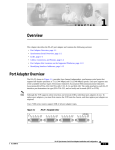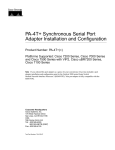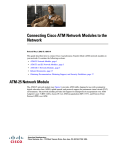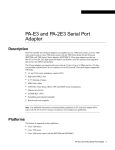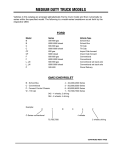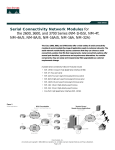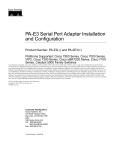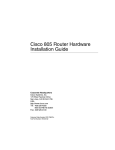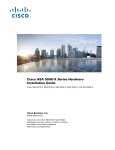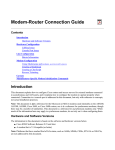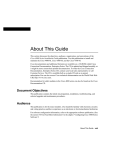Download Cisco CAB-232MT= serial cable
Transcript
A P P E N D I X C Cable Specifications This appendix provides the following cabling and pinout information for the Cisco 7100 series routers: Note • Console and Auxiliary Port Cables and Pinouts, page C-1 • Fast Ethernet Port Cables and Pinouts, page C-4 • Cisco 7120-4T1 and Cisco 7140-8T Cables and Pinouts, page C-5 • Cisco 7120-T3, Cisco 7120-E3, Cisco 7140-2T3, and Cisco 7140-2E3 Cables, page C-18 • Cisco 7120-AT3, Cisco 7140-2AT3, Cisco 7120-AE3, Cisco 7140-2AE3, Cisco 7120-SMI3, and Cisco 7140-2MM3 Cables, page C-19 This appendix specifies pinouts only for the pins used. Pins not listed in the tables in this appendix are not connected. Console and Auxiliary Port Cables and Pinouts The router arrives with a console and auxiliary cable kit, which contains the cable and adapters you need to connect a console (an ASCII terminal or PC running terminal emulation software) or modem to the router. The console and auxiliary cable kit includes: • RJ-45-to-RJ-45 rollover cable • RJ-45-to-DB-9 female data terminal equipment (DTE) adapter labeled TERMINAL • RJ-45-to-DB-25 female DTE adapter labeled TERMINAL • RJ-45-to-DB-25 male data communications equipment (DCE) adapter labeled MODEM Cisco 7100 Series VPN Router Installation and Configuration Guide 78-6341-03 C-1 Appendix C Cable Specifications Console and Auxiliary Port Cables and Pinouts Identifying a Rollover Cable You can identify a rollover cable by comparing the two modular ends of the cable. Holding the cables side-by-side, with the tab at the back, the wire connected to the pin on the outside of the left plug should be the same color as the wire connected to the pin on the outside of the right plug. (See Figure C-1.) If your cable was purchased from Cisco Systems, pin 1 will be white on one connector, and pin 8 will be white on the other connector (a rollover cable reverses pins 1 and 8, 2 and 7, 3 and 6, and 4 and 5). Identifying a Rollover Cable H5663 Figure C-1 Console Port Cables and Pinouts Use the RJ-45-to-RJ-45 rollover cable and RJ-45-to-DB-9 female DTE adapter (labeled TERMINAL) to connect the console port to a PC running terminal emulation software. Table C-1 lists the signals and pinouts for the asynchronous serial console port, the RJ-45-to-RJ-45 rollover cable, and the RJ-45-to-DB-9 female DTE adapter (labeled TERMINAL). Table C-1 Console Port Signaling and Cabling Using a DB-9 Adapter Console Port (DTE) RJ-45-to-RJ-45 Rollover Cable RJ-45-to-DB-9 Terminal Adapter Console Device Signal RJ-45 Pin RJ-45 Pin DB-9 Pin Signal 8 8 CTS 1 RTS 1 DTR 2 7 6 DSR TxD 3 6 2 RxD GND 4 5 5 GND GND 5 4 5 GND RxD 6 3 3 TxD DSR 7 2 4 DTR CTS 81 1 7 RTS 1. Pin 1 is connected internally to pin 8. Cisco 7100 Series VPN Router Installation and Configuration Guide C-2 78-6341-03 Appendix C Cable Specifications Console and Auxiliary Port Cables and Pinouts Use the RJ-45-to-RJ-45 rollover cable and RJ-45-to-DB-25 female DTE adapter (labeled TERMINAL) to connect the console port to a terminal. Table C-2 lists the signals and pinouts for the asynchronous serial console port, the RJ-45-to-RJ-45 rollover cable, and the RJ-45-to-DB-25 female DTE adapter (labeled TERMINAL). Table C-2 Console Port Signaling and Cabling Using a DB-25 Adapter Console Port (DTE)1 RJ-45-to-RJ-45 Rollover Cable RJ-45-to-DB-25 Terminal Adapter Console Device Signal RJ-45 Pin RJ-45 Pin DB-25 Pin Signal 8 5 CTS 2 RTS 1 DTR 2 7 6 DSR TxD 3 6 3 RxD GND 4 5 7 GND GND 5 4 7 GND RxD 6 3 2 TxD DSR 7 2 20 DTR 1 4 RTS CTS 8 1 1. You can use the same cabling to connect a console to the auxiliary port. 2. Pin 1 is connected internally to pin 8. Auxiliary Port Cables and Pinouts Use the RJ-45-to-RJ-45 rollover cable and RJ-45-to-DB-25 male DCE adapter (labeled MODEM) to connect the auxiliary port to a modem. Table C-3 lists the signals and pinouts for the asynchronous serial auxiliary port, the RJ-45-to-RJ-45 rollover cable, and the RJ-45-to-DB-25 male DCE adapter (labeled MODEM). Table C-3 Auxiliary Port Signaling and Cabling Using a DB-25 Adapter AUX Port (DTE) RJ-45-to-RJ-45 Rollover Cable RJ-45-to-DB-25 Modem Adapter Modem (DCE) Signal RJ-45 Pin RJ-45 Pin DB-25 Pin Signal RTS 1 8 4 RTS DTR 2 7 20 DTR TxD 3 6 3 TxD GND 4 5 7 GND GND 5 4 7 GND RxD 6 3 2 RxD DSR 7 2 8 DCD CTS 8 1 5 CTS Cisco 7100 Series VPN Router Installation and Configuration Guide 78-6341-03 C-3 Appendix C Cable Specifications Fast Ethernet Port Cables and Pinouts Fast Ethernet Port Cables and Pinouts The 10BaseT/100BaseTX Fast Ethernet ports support IEEE 802.3 and IEEE 802.3u specifications for 10-Mbps and 100-Mbps transmission over unshielded twisted-pair (UTP) cables. Each Fast Ethernet port on the router has an RJ-45 connector to attach to Category 3 or Category 5 UTP cables. Cisco Systems does not supply Category 3 or Category 5 UTP RJ-45 cables; these cables are available commercially. Use a Category 3 UTP crossover cable when connecting 10BaseT port to a hub or use a Category 3 UTP straight-through cable when connecting to an end station. Use a Category 5 UTP crossover cable when connecting 100BaseTX to a hub or use a Category 5 UTP straight-through cable when connecting to an end station. To determine the type of RJ-45 cable, examine the sequence of colored wires as follows: • Straight-through—Colored wires are in the same sequence at both ends of the cable. • Crossover—The first (far left) colored wire at one end of the cable is the third colored wire at the other end of the cable, and the second colored wire at one end of the cable is the sixth colored wire at the other end of the cable. Table C-4 lists the 10BaseT pinouts and Table C-5 lists the 100BaseTX pinouts for the two Fast Ethernet ports. Table C-4 10BaseT RJ-45 Connector Pinouts RJ-45 Pin Description 1 Tx+ 2 Tx– 3 Rx+ 6 Rx– Table C-5 100BaseTX RJ-45 Connector Pinouts RJ-45 Pin Description 1 Tx+ 2 Tx– 3 Rx+ 6 Rx– Cisco 7100 Series VPN Router Installation and Configuration Guide C-4 78-6341-03 Appendix C Cable Specifications Cisco 7120-4T1 and Cisco 7140-8T Cables and Pinouts Figure C-2 shows the RJ-45 cable connectors. RJ-45 Plug and Receptacle 87654321 RJ-45 connector H2936 Figure C-2 Cisco 7120-4T1 and Cisco 7140-8T Cables and Pinouts The four T1 ports on the Cisco 7120-4T1 and the eight T1 ports on the Cisco 7140-8T and adapter cables allow a high density of interface ports, regardless of the size of the connectors typically used with each electrical interface type. All ports use an identical 60-pin D-shell receptacle that supports all interface types: • EIA/TIA-232 • V.35 • EIA/TIA-449 • X.21 • EIA-530 Each port requires a serial adapter cable, which provides the interface between the high-density serial port and the standard connectors that are commonly used for each electrical interface type. Note The adapter cable determines the electrical interface type and mode of the port (DTE or DCE) to which it is connected. The network end of the cable is an industry-standard connector for the type of electrical interface that the cable supports. For most interface types, the adapter cable for DTE mode uses a plug at the network end, and the cable for DCE mode uses a receptacle at the network end. Exceptions are V.35 adapter cables, which are available with either a V.35 plug or a receptacle for either mode, and the EIA-530 adapter cable, which is available only in DTE mode with a DB-25 plug at the network end. The mode is labeled on the molded plastic connector shell at the ends of all cables except V.35 (which uses the standard Winchester block-type connector instead of a molded plastic D shell). Caution Serial interface cables must be attached correctly, or damage to the cable plug will result. Attempting to force a cable plug on the 60-pin receptacle can damage the plug. (See Figure C-3.) Cisco 7100 Series VPN Router Installation and Configuration Guide 78-6341-03 C-5 Appendix C Cable Specifications Cisco 7120-4T1 and Cisco 7140-8T Cables and Pinouts Figure C-3 Correct Serial Cable Orientation Correct Interface cable Router port Interface cable Router port 22138 Incorrect, cable upside down Table C-6 lists the available interface cable options (and product numbers) for the mode and network-end connectors. Table C-6 Serial Cable Product Numbers Interface Type Description Product Number EIA/TIA-232 DTE mode with a DB-25 plug CAB-232MT= DCE mode with a DB-25 receptacle CAB-232FC= DTE mode with a 37-pin D-shell plug CAB-449MT= DCE mode with a 37-pin D-shell receptacle CAB-449C= DTE mode or DCE mode with a 34-pin Winchester-type V.35 plug CAB-V35MT= or CAB-V35MC= DTE mode or DCE mode with a 34-pin Winchester-type V.35 receptacle CAB-V35FT= or CAB-V35FC= Male DB-60 plug on the router end and a male DB-34 shielded plug on the network end CAB-V35MTS= DTE mode with a DB-15 plug CAB-X21MT= DCE mode with a DB-25 receptacle CAB-X21FC= DTE mode with a DB-25 plug CAB-530MT= EIA/TIA-449 V.35 X.21 EIA-530 Cisco 7100 Series VPN Router Installation and Configuration Guide C-6 78-6341-03 Appendix C Cable Specifications Cisco 7120-4T1 and Cisco 7140-8T Cables and Pinouts Figure C-4 shows the supported serial cables. Figure C-4 T1 Serial Cables 23975 Router connections EIA/TIA-449 EIA/TIA-232 V.35 X.21 EIA-530 Network connections at the modem or CSU/DSU Metric (M3) thumbscrews are included with each cable to allow connections to devices that use metric hardware. Because the T1 ports use a special, high-density port that requires special adapter cables for each electrical interface type, we recommend that you obtain serial interface cables from the factory. Serial signals can travel a limited distance at any given bit rate; generally, the slower the baud rate, the greater the distance. All serial signals are subject to distance limits beyond which a signal degrades significantly or is completely lost. Table C-7 lists the recommended (standard) maximum speeds and distances for each serial interface type. The recommended maximum rate for V.35 is 2.048 Mbps. Table C-7 Recommended (Standard) Maximum Speeds and Distances for Serial Interfaces EIA/TIA-232 Distances EIA/TIA-449, X.21, V.35, EIA-530 Distances Rate (bps) Feet Meters Feet Meters 2400 200 60 4,100 1,250 4800 100 30 2,050 625 9600 50 15 1,025 312 19200 25 7.6 513 156 38400 12 3.7 256 78 Cisco 7100 Series VPN Router Installation and Configuration Guide 78-6341-03 C-7 Appendix C Cable Specifications Cisco 7120-4T1 and Cisco 7140-8T Cables and Pinouts Table C-7 Recommended (Standard) Maximum Speeds and Distances for Serial Interfaces (continued) EIA/TIA-232 Distances EIA/TIA-449, X.21, V.35, EIA-530 Distances 56000 8.6 2.6 102 31 1544000 (T1) – – 50 15 Balanced drivers allow EIA/TIA-449 signals to travel greater distances than EIA/TIA-232 signals. The recommended distance limits for EIA/TIA-449 shown in Table C-7 are also valid for V.35, X.21, and EIA-530. EIA/TIA-449 and EIA-530 support 2.048-Mbps rates, and V.35 supports 2.048-Mbps rates without any problems; we do not recommend exceeding published specifications for transmission speed versus distance. Do so at your own risk. EIA/TIA-232 Connections The router end of all EIA/TIA-232 adapter cables is a high-density 60-pin plug. The network end of the adapter cable is a standard 25-pin D-shell connector (known as a DB-25) that is commonly used for EIA/TIA-232 connections. Figure C-5 shows the connectors at the network end of the adapter cable. Do not use the Cisco Systems-provided EIA/TIA-232 adapter cable product number CAB-232MT= to connect a T1 interface that is configured for DTE mode directly to an NEC - NEXTSTAR 1E model C4969 MD/SAC unit interface that is configured for DCE mode. Doing so will keep transmit and receive data signals from being properly exchanged between the two interfaces. Instead, you must connect an additional, intermediate adapter cable—with standard EIA/TIA-232 DB-25 connectors at both ends—from the network end of product number CAB-232MT= to the standard EIA/TIA-232 DB-25 connector (the DCE interface) on the NEC - NEXTSTAR 1E model C4969 MD/SAC unit. Cisco Systems does not provide this additional cable; however, its signals and pin assignments are listed in Table C-8. You can use the Cisco Systems-provided EIA/TIA-232 adapter cable product number CAB-232FC= to connect a T1 interface that is configured for DCE mode directly to an NEC - NEXTSTAR 1E model C4969 MD/SAC unit interface that is configured for DTE mode. This cable’s pin assignments are listed in Table C-9. Figure C-5 EIA/TIA-232 Adapter Cable Connectors DCE Table C-8 H1343a DTE EIA/TIA-232 Adapter Cable Signals (DTE) DTE Cable (CAB-232MT=) Router End, HD1 60-Position Plug Signal Network End, DB-25 Plug Pin Pin Signal Cisco 7100 Series VPN Router Installation and Configuration Guide C-8 78-6341-03 Appendix C Cable Specifications Cisco 7120-4T1 and Cisco 7140-8T Cables and Pinouts Table C-8 EIA/TIA-232 Adapter Cable Signals (DTE) (continued) DTE Cable (CAB-232MT=) Shield ground 46 – 1 Shield ground TxD/RxD 41 —> 2 TxD RxD/TxD 36 <— 3 RxD RTS/CTS 42 —> 4 RTS CTS/RTS 35 <— 5 CTS DSR/DTR 34 <— 6 DSR Circuit ground 45 – 7 Circuit ground DCD/LL 33 <— 8 DCD TxC/NIL 37 <— 15 TxC RxC/TxCE 38 <— 17 RxC LL/DCD 44 —> 18 LTST DTR/DSR 43 —> 20 DTR TxCE/TxC 39 —> 24 TxCE Mode 0 Ground Mode_DCE 50 51 52 – – Shorting group 1. HD = high-density. Table C-9 EIA/TIA-232 Adapter Cable Signals (DCE) DCE Cable (CAB-232FC=) Router End, HD1 60-Position Plug Network End, DB-25 Receptacle Signal Pin Pin Signal Shield ground 46 – 1 Shield ground RxD/TxD 36 <— 2 TxD TxD/RxD 41 —> 3 RxD CTS/RTS 35 <— 4 RTS RTS/CTS 42 —> 5 CTS DTR/DSR 43 —> 6 DSR Circuit ground 45 – 7 Circuit ground LL/DCD 44 —> 8 DCD TxCE/TxC 39 —> 15 TxC NIL/RxC 40 —> 17 RxC DCD/LL 33 <— 18 LTST DSR/DTR 34 <— 20 DTR Cisco 7100 Series VPN Router Installation and Configuration Guide 78-6341-03 C-9 Appendix C Cable Specifications Cisco 7120-4T1 and Cisco 7140-8T Cables and Pinouts Table C-9 EIA/TIA-232 Adapter Cable Signals (DCE) (continued) DCE Cable (CAB-232FC=) RxC/TxCE 38 <— 24 TxCE Mode 0 Ground 50 51 – – Shorting group 1. HD = high-density. EIA/TIA-449 Connections The router end of all EIA/TIA-449 adapter cables is a high-density 60-pin plug. The network end of the adapter cable provides a standard 37-pin D-shell connector, which is commonly used for EIA/TIA-449 connections. Figure C-6 shows the connectors at the network end of the adapter cable. EIA/TIA-449 cables are available as either DTE (DB-37 plug) or DCE (DB-37 receptacle). See Table C-10 and Table C-11 for pinouts. Figure C-6 EIA/TIA-449 Adapter Cable Connectors DCE H1344a DTE Table C-10 EIA/TIA-449 Adapter Cable Signals (DTE) DTE Cable (CAB-449MT=) Router End, HD1 60-Position Plug Network End, DB-37 Plug Signal Pin Pin Signal Shield ground 46 – 1 Shield ground TxD/RxD+ 11 —> 4 SD+ TxD/RxD– 12 —> 22 SD– TxC/RxC+ 24 <— 5 ST+ TxC/RxC– 23 <— 23 ST– RxD/TxD+ 28 <— 6 RD+ RxD/TxD– 27 <— 24 RD– RTS/CTS+ 9 —> 7 RS+ RTS/CTS– 10 —> 25 RS– RxC/TxCE+ 26 <— 8 RT+ RxC/TxCE– 25 <— 26 RT– CTS/RTS+ 1 <— 9 CS+ CTS/RTS– 2 <— 27 CS– Cisco 7100 Series VPN Router Installation and Configuration Guide C-10 78-6341-03 Appendix C Cable Specifications Cisco 7120-4T1 and Cisco 7140-8T Cables and Pinouts Table C-10 EIA/TIA-449 Adapter Cable Signals (DTE) (continued) DTE Cable (CAB-449MT=) LL/DCD 44 —> 10 LL Circuit ground 45 – 37 SC DSR/DTR+ 3 <— 11 ON+ DSR/DTR– 4 <— 29 ON– DTR/DSR+ 7 —> 12 TR+ DTR/DSR– 8 —> 30 TR– DCD/DCD+ 5 <— 13 RR+ DCD/DCD– 6 <— 31 RR– TxCE/TxC+ 13 —> 17 TT+ TxCE/TxC– 14 —> 35 TT– Circuit ground 15 – 19 SG Circuit ground 16 – 20 RC Mode 1 Ground 49 48 – – Shorting group Ground Mode_DCE 51 52 – – Shorting group 1. HD = high-density. Table C-11 EIA/TIA-449 Adapter Cable Signals (DCE) DCE Cable (CAB-449C=) Router End, HD1 60-Position Plug Network End, DB-37 Receptacle Signal Pin Pin Signal Shield ground 46 – 1 Shield ground RxD/TxD+ 28 <— 4 SD+ RxD/TxD– 27 <— 22 SD– TxCE/TxC+ 13 —> 5 ST+ TxCE/TxC– 14 —> 23 ST– TxD/RxD+ 11 —> 6 RD+ TxD/RxD– 12 —> 24 RD– CTS/RTS+ 1 <— 7 RS+ CTS/RTS– 2 <— 25 RS– TxC/RxC+ 24 —> 8 RT+ TxC/RxC– 23 —> 26 RT– RTS/CTS+ 9 —> 9 CS+ RTS/CTS– 10 —> 27 CS– Cisco 7100 Series VPN Router Installation and Configuration Guide 78-6341-03 C-11 Appendix C Cable Specifications Cisco 7120-4T1 and Cisco 7140-8T Cables and Pinouts Table C-11 EIA/TIA-449 Adapter Cable Signals (DCE) (continued) DCE Cable (CAB-449C=) NIL/LL 29 —> 10 LL Circuit ground 30 – 37 SC DTR/DSR+ 7 —> 11 ON+ DTR/DSR– 8 —> 29 ON– DSR/DTR+ 3 <— 12 TR+ DSR/DTR– 4 <— 30 TR– DCD/DCD+ 5 —> 13 RR+ DCD/DCD– 6 —> 31 RR– RxC/TxCE+ 26 <— 17 TT+ RxC/TxCE– 25 <— 35 TT– Circuit ground 15 – 19 SG Circuit ground 16 – 20 RC Mode 1 Ground 49 48 – – Shorting group 1. HD = high-density. V.35 Connections The router end of all V.35 adapter cables is a high-density 60-pin plug. The network end of the adapter cable provides a standard 34-pin Winchester-type connector commonly used for V.35 connections. Figure C-7 shows the connectors at the network end of the V.35 adapter cable. V.35 cables are available with a standard V.35 plug for DTE mode (CAB-V35MT=) or a V.35 receptacle for DCE mode (CAB-V35FC=). See Table C-12 and Table C-13 for pinouts. Figure C-7 V.35 Adapter Cable Connectors DCE H1616a DTE Also available, but not shown in Figure C-7, are CAB-V35MC=, a V.35 cable with a plug on the network end for DCE mode, and CAB-V35FT=, a V.35 cable with a receptacle on the network end for DTE mode. These cables are used for connecting V.35-equipped systems back to back. Cisco 7100 Series VPN Router Installation and Configuration Guide C-12 78-6341-03 Appendix C Cable Specifications Cisco 7120-4T1 and Cisco 7140-8T Cables and Pinouts Table C-12 V.35 Adapter Cable Signals (DTE) DTE Cable (CAB-V35FT= or CAB-V35MT=) Router End, HD1 60-Position Plug Network End, 34-Position Plug Signal Pin Pin Signal Shield ground 46 – A Frame ground Circuit ground 45 – B Circuit ground RTS/CTS 42 —> C RTS CTS/RTS 35 <— D CTS DSR/DTR 34 <— E DSR DCD/LL 33 <— F RLSD DTR/DSR 43 —> H DTR LL/DCD 44 —> K LT TxD/RxD+ 18 —> P SD+ TxD/RxD– 17 —> S SD– RxD/TxD+ 28 <— R RD+ RxD/TxD– 27 <— T RD– TxCE/TxC+ 20 —> U SCTE+ TxCE/TxC– 19 —> W SCTE– RxC/TxCE+ 26 <— V SCR+ RxC/TxCE– 25 <— X SCR– TxC/RxC+ 24 <— Y SCT+ TxC/RxC– 23 <— AA SCT– Mode 1 Ground 49 48 – – Shorting group Mode 0 Ground Mode_DCE 50 51 52 – – Shorting group TxC/NIL RxC/TxCE RxC/TxD Ground 53 54 55 56 – – Shorting group 1. HD = high-density. Table C-13 V.35 Adapter Cable Signals (DCE) DCE Cable (CAB-V35FC= or CAB-V35MC=) Router End, HD1 60-Position Plug Signal Network End, 34-Position Receptacle Pin Pin Signal Cisco 7100 Series VPN Router Installation and Configuration Guide 78-6341-03 C-13 Appendix C Cable Specifications Cisco 7120-4T1 and Cisco 7140-8T Cables and Pinouts Table C-13 V.35 Adapter Cable Signals (DCE) (continued) DCE Cable (CAB-V35FC= or CAB-V35MC=) Shield ground 46 – A Frame ground Circuit ground 45 – B Circuit ground CTS/RTS 35 <— C RTS RTS/CTS 42 —> D CTS DTR/DSR 43 —> E DSR LL/DCD 44 —> F RLSD DSR/DTR 34 <— H DTR DCD/LL 33 <— K LT RxD/TxD+ 28 <— P SD+ RxD/TxD– 27 <— S SD– TxD/RxD+ 18 —> R RD+ TxD/RxD– 17 —> T RD– RxC/TxCE+ 26 <— U SCTE+ RxC/TxCE– 25 <— W SCTE– NIL/RxC+ 22 —> V SCR+ NIL/RxC– 21 —> X SCR– TxCE/TxC+ 20 —> Y SCT+ TxCE/TxC– 19 —> AA SCT– Mode 1 Ground 49 48 – – Shorting group Mode 0 Ground 50 51 – – Shorting group TxC/NIL RxC/TxCE RxC/TxD Ground 53 54 55 56 – – Shorting group 1. HD = high-density. Cisco 7100 Series VPN Router Installation and Configuration Guide C-14 78-6341-03 Appendix C Cable Specifications Cisco 7120-4T1 and Cisco 7140-8T Cables and Pinouts X.21 Connections The router end of all X.21 adapter cables is a high-density 60-pin plug. The network end of the adapter cable is a standard DB-15 connector. Figure C-8 shows the connectors at the network end of the X.21 adapter cable. X.21 cables are available as either DTE (DB-15 plug) or DCE (DB-15 receptacle). See Table C-14 and Table C-15 for pinouts. Figure C-8 X.21 Adapter Cable Connectors DTE 15 H1346a 1 8 DCE 9 Table C-14 X.21 Adapter Cable Signals (DTE) DTE Cable (CAB-X21MT=) Router End, HD1 60-Position Plug Network End, DB-15 Plug Signal Pin Pin Signal Shield ground 46 – 1 Shield ground TxD/RxD+ 11 —> 2 Transmit+ TxD/RxD– 12 —> 9 Transmit– RTS/CTS+ 9 —> 3 Control+ RTS/CTS – 10 —> 10 Control– RxD/TxD+ 28 <— 4 Receive+ RxD/TxD– 27 <— 11 Receive– CTS/RTS+ 1 <— 5 Indication+ CTS/RTS – 2 <— 12 Indication– RxC/TxCE+ 26 <— 6 Timing+ RxC/TxCE– 25 <— 13 Timing– Circuit ground 15 – 8 Circuit ground Ground Mode_2 48 47 – – Shorting group Ground Mode_DCE 51 52 – – Shorting group 1. HD = high-density. Cisco 7100 Series VPN Router Installation and Configuration Guide 78-6341-03 C-15 Appendix C Cable Specifications Cisco 7120-4T1 and Cisco 7140-8T Cables and Pinouts Table C-15 X.21 Adapter Cable Signals (DCE) DCE Cable (CAB-X21FC=) Router End, HD1 60-Position Plug Network End, DB-15 Receptacle Signal Pin Pin Signal Shield ground 46 – 1 Shield ground RxD/TxD+ 11 —> 2 Transmit+ RxD/TxD– 12 —> 9 Transmit– CTS/RTS+ 9 —> 3 Control+ CTS/RTS – 10 —> 10 Control– TxD/RxD+ 28 <— 4 Receive+ TxD/RxD– 27 <— 11 Receive– RTS/CTS+ 1 <— 5 Indication+ RTS/CTS– 2 <— 12 Indication– TxC/RxC+ 26 <— 6 Timing+ TxC/RxC – 25 <— 13 Timing– Circuit ground 15 – 8 Circuit ground Ground Mode_2 48 47 – – Shorting group Ground Mode_DCE 51 52 – – – 1. HD = high-density. EIA-530 Connections The EIA-530 adapter cable is available in DTE mode only. The router end of the EIA-530 adapter cable is a high-density 60-pin plug. The network end of the adapter cable is a standard DB-25 plug commonly used for EIA/TIA-232 connections. Figure C-9 shows the DB-25 connector at the network end of the adapter cable. EIA-530 Adapter Cable Connector H1615a Figure C-9 DTE Table C-16 EIA-530 DTE Adapter Cable Signals (CAB-530MT=) Router End, HD1 60-Position Plug Network End, DB-25 Plug Signal Pin Shield ground 46 – Pin Signal 1 Shield ground Cisco 7100 Series VPN Router Installation and Configuration Guide C-16 78-6341-03 Appendix C Cable Specifications Cisco 7120-4T1 and Cisco 7140-8T Cables and Pinouts Table C-16 EIA-530 DTE Adapter Cable Signals (CAB-530MT=) Router End, HD1 60-Position Plug Network End, DB-25 Plug TxD/RxD+ 11 —> 2 TxD+ TxD/RxD– 12 —> 14 TxD– RxD/TxD+ 28 <— 3 RxD+ RxD/TxD– 27 <— 16 RxC– RTS/CTS+ 9 —> 4 RTS+ RTS/CTS– 10 —> 19 RTS– CTS/RTS+ 1 <— 5 CTS+ CTS/RTS– 2 <— 13 CTS– DSR/DTR+ 3 <— 6 DSR+ DSR/DTR– 4 <— 22 DSR– DCD/DCD+ 5 <— 8 DCD+ DCD/DCD– 6 <— 10 DCD– TxC/RxC+ 24 <— 15 TxC+ TxC/RxC– 23 <— 12 TxC– RxC/TxCE+ 26 <— 17 RxC+ RxC/TxCE– 25 <— 9 RxC– LL/DCD 44 —> 18 LL Circuit ground 45 – 7 Circuit ground DTR/DSR+ 7 —> 20 DTR+ DTR/DSR– 8 —> 23 DTR– TxCE/TxC+ 13 —> 24 TxCE+ TxCE/TxC– 14 —> 11 TxCE– Mode_1 Ground Mode_2 49 48 47 – – Shorting group Ground Mode_DCE 51 52 – – Shorting group 1. HD = high-density. Cisco 7100 Series VPN Router Installation and Configuration Guide 78-6341-03 C-17 Appendix C Cable Specifications Cisco 7120-T3, Cisco 7120-E3, Cisco 7140-2T3, and Cisco 7140-2E3 Cables Cisco 7120-T3, Cisco 7120-E3, Cisco 7140-2T3, and Cisco 7140-2E3 Cables The T3 or E3 serial interface cable on the Cisco 7120 and Cisco 7140 series, which is a 75-ohm coaxial cable, is used to connect your router to a T3 or E3 serial network. Serial cables conform to EIA/TIA-612 and EIA/TIA-613 specifications. The serial ports are considered to be DTE devices. The T3 or E3 serial port has two connectors (receive and transmit) where you connect the Cisco 75-ohm coaxial cable. The 75-ohm coaxial cable (Cisco product number CAB-ATM-DS3/E3), is available only from Cisco Systems; it is not available from outside commercial cable vendors. Figure C-10 shows the Cisco 75-ohm coaxial cable, which is available in 10-foot (3.05-meter) lengths only. The typical maximum distance between stations for T3 or E3 transmissions is 1300 feet (396 meters). Note For E3 (75-ohm) connections, you must have ferrite beads on the 75-ohm coaxial cable and electromagnetic interference (EMI) decoupling clips on the receiver end of the cable (see Figure C-10) if compliance with European certification standards for emission control is required (EN55022/CISPR22 Class B for radiated emission levels). Figure C-10 T3 and E3 Serial Port Adapter Cables 75-ohm coaxial cabling BNC plug I RCVR EN XMTR RCLK FERF RL RCLK FERF RL RCVR BNC plug 22139 5 XMTR AIS OOF LL AIS OOF LL EMI decoupler clip Ferrite bead To T3 network equipment The T3 and E3 ports support several types of integrated data service units (DSUs). Table C-17 lists the features supported. Table C-17 Feature Compatibilities of T3 and E3 Serial Port DSUs Device Full Rate Scrambling Subrate MDL1 Yes Yes Yes No T3 DSU DL3100 Kentrox Yes Yes Larscom Yes Yes 2 Yes Yes 2 No No E3 DSU Cisco 7100 Series VPN Router Installation and Configuration Guide C-18 78-6341-03 Appendix C Cable Specifications Cisco 7120-AT3, Cisco 7140-2AT3, Cisco 7120-AE3, Cisco 7140-2AE3, Cisco 7120-SMI3, and Cisco 7140-2MM3 Cables Table C-17 Feature Compatibilities of T3 and E3 Serial Port DSUs (continued) Device Full Rate Scrambling Subrate MDL1 DL3100E Yes No3 Yes3 No 2 No Kentrox Yes Yes 2 Yes 1. MDL = Maintenance Digital Link. 2. T3 and E3 serial ports support either scrambling or Kentrox subrate, not both at the same time. 3. DL3100E does not support scrambling. However, the E3 serial port can turn on scrambling in DSU mode 0 for connecting to another E3 serial port. The E3 serial port supports either scrambling (in mode 0) or DL3100E subrate, not both at the same time. Cisco 7120-AT3, Cisco 7140-2AT3, Cisco 7120-AE3, Cisco 7140-2AE3, Cisco 7120-SMI3, and Cisco 7140-2MM3 Cables The AT3, AE3, MM3 (OC-3c/STM-1 multimode), and SMI3 (OC-3c/STM-1 single-mode intermediate reach) interfaces in Cisco 7120 series and Cisco 7140 series routers are full duplex. You must use the appropriate ATM interface cable to connect the interface with an external ATM network. These interfaces are considered DTE devices. Table C-18 summarizes the interface types, connectors, and cables. Table C-18 AT3, AE3, MM3, and SMI3 Connector Types and Cables Note Interface Rate (Mbps) Connector Type ITU-T G.957 Cable Type Standard Bellcore GR-253 Standard Wavelength Maximum Distance AT3 44.736 BNC Coaxial – – – 450 ft (137.2 m) AE3 34.368 BNC Coaxial – – – 1250 ft (381 m) MM3 155.52 SC 62.5/125 Intra-office microns STM-1 I-1 multimode SMI3 155.52 SC Intermediat 1310 nm 9 microns Short-haul single mod STM-1 S-1.1 e reach e OC3 Short reach 1310 nm OC3 1.2 mi (2 km) 9.3 mi (15 km) The ATM port is considered a DTE device. Cisco 7100 Series VPN Router Installation and Configuration Guide 78-6341-03 C-19 Appendix C Cable Specifications Cisco 7120-AT3, Cisco 7140-2AT3, Cisco 7120-AE3, Cisco 7140-2AE3, Cisco 7120-SMI3, and Cisco 7140-2MM3 Cables AT3 and AE3 Cables and Receptacles The AT3 and AE3 interfaces provide an interface to ATM switching fabrics for the bidirectional transmission and reception of data at rates of up to 45 Mbps (for T3) and 34 Mbps (for E3). The AT3 and AE3 interfaces use a 75-ohm coaxial interface cable to connect your router to an ATM T3 or E3 network. The AT3 and AE3 cables (see Figure C-11) conform to EIA/TIA-612 and EIA/TIA-613 specifications. The AT3 and AE3 ports are considered DTE devices. Figure C-11 AT3 and AE3 Cables 75-ohm coaxial cabling I DS3 EN RX TX RX CEL CAR ALM BNC plug 22878 BNC plug 5 Ferrite bead To ATM network equipment AT3 or AE3 ports consist of two connectors, transmit and receive. The 75-ohm coaxial cable (Cisco product number CAB-ATM-DS3/E3) is available only from Cisco Systems; it is not available from outside commercial cable vendors. The Cisco 75-ohm coaxial cable is available only in 10-foot (3.05-meter) lengths. The typical maximum distance between stations for T3 and E3 transmissions is 1300 feet (396 meters). Note To ensure compliance with EMI and European certification standards for emission control (EN55022/CISPR22 Class B for radiated emission levels), the transmit and receive cables should be tied together along their entire length, and ferrite beads should be installed on each cable near the transmit and receive connectors. Cisco 7100 Series VPN Router Installation and Configuration Guide C-20 78-6341-03 Appendix C Cable Specifications Cisco 7120-AT3, Cisco 7140-2AT3, Cisco 7120-AE3, Cisco 7140-2AE3, Cisco 7120-SMI3, and Cisco 7140-2MM3 Cables MM3 and SMI3 Cables and Receptacles The MM3 (OC-3c/STM-1 multimode) and SMI3 (OC-3c/STM-1 single-mode intermediate reach) interfaces provides an interface to ATM switching fabrics for transmitting and receiving data at rates of up to 155 Mbps bidirectionally. The MME and SMI3 interfaces connect to SONET/SDH, 155-Mbps multimode or single-mode optical fiber. For SONET/SDH multimode and SONET/SDH single-mode connections, use one duplex SC connector (see Figure C-12) or two simplex SC connectors (see Figure C-13). The simplex and duplex SC connectors are shipped with removable dust covers on each connector. H2214 Figure C-12 Duplex SC Connector H2399 Figure C-13 Simplex SC Connector An OC-3 ATM interface cable, which is used to connect your router to an external DSU (an ATM network), is available for use with the MM3 and SMI3 interfaces. Cables can be obtained from an outside cable vendor. Single-mode and multimode cables should perform to the specifications listed in Table C-19. Table C-19 Fiber-Optic Cable Specifications Standard Maximum Path Length Cabling ISO/IEC 9314-3 1.2 miles (2 km) all cables in a 62.5-micron core with an connection, end to end optical loss of 0–9 dB, or 50-micron core with an optical loss of 7 dB IEC 793-2 24.8 mi (40 km) for SML1 and 9-micron core 9.3 mi (15 km) for SMI2 ANSI/TIA/EIA-492CAAA 24.8 mi (40 km) for SML and 9.3 mi (15 km) for SMI 9-micron core 1. SML = single-mode long reach. 2. SMI = single-mode intermediate reach. Cisco 7100 Series VPN Router Installation and Configuration Guide 78-6341-03 C-21 Appendix C Cable Specifications Cisco 7120-AT3, Cisco 7140-2AT3, Cisco 7120-AE3, Cisco 7140-2AE3, Cisco 7120-SMI3, and Cisco 7140-2MM3 Cables Note A single fiber link should not mix 62.5- and 50-micron cable. Fiber-Optic Transmission Specifications The following sections describe the SONET specifications for fiber-optic transmissions, define the power budget, and help you approximate the power margin for multimode and single-mode transmissions. For more information on determining attenuation and power budget, see the following publications: • T1E1.2/92-020R2 ANSI, the Draft American National Standard for Telecommunications entitled Broadband ISDN Customer Installation Interfaces: Physical Layer Specification. • Power Margin Analysis, AT&T Technical Note, TN89-004LWP, May 1989 SONET Distance Limitations The SONET specification for fiber-optic transmission defines two types of fiber: single mode and multimode. Modes can be thought of as bundles of light rays entering the fiber at a particular angle. Single-mode fiber allows only one mode of light to propagate through the fiber, whereas multimode fiber allows multiple modes of light to propagate through the fiber. Because multiple modes of light propagating through the fiber travel different distances depending on the entry angles, causing them to arrive at the destination at different times (a phenomenon called modal dispersion), single-mode fiber is capable of higher bandwidth and greater cable run distances than multimode fiber. The typical maximum distances for single-mode and multimode transmissions, as defined by SONET, are in Table C-20. If the distance between two connected stations is greater than this maximum distance, significant signal loss can result, making transmission unreliable. Table C-20 SONET Maximum Fiber-Optic Transmission Distances Transceiver Type Maximum Distance between Stations1 Single-mode long reach (SML) Up to 24.8 miles (40 kilometers) Single-mode intermediate reach (SMI) Up to 9.3 miles (15 kilometers) Multimode (MM) Up to 1.2 miles (2 kilometers) 1. Table C-20 gives typical results. Use the power budget calculations described in the following sections to determine the actual distances. Power Budget To design an efficient optical data link, evaluate the power budget. The power budget is the amount of light available to overcome attenuation in the optical link and to exceed the minimum power that the receiver requires to operate within its specifications. Proper operation of an optical data link depends on modulated light reaching the receiver with enough power to be correctly demodulated. Attenuation, caused by the passive media components (cables, cable splices, and connectors), is common to both multimode and single-mode transmission. The following variables reduce the power of the signal (light) transmitted to the receiver in multimode transmission: Cisco 7100 Series VPN Router Installation and Configuration Guide C-22 78-6341-03 Appendix C Cable Specifications Cisco 7120-AT3, Cisco 7140-2AT3, Cisco 7120-AE3, Cisco 7140-2AE3, Cisco 7120-SMI3, and Cisco 7140-2MM3 Cables • Chromatic dispersion—Spreading of the signal in time because of the different speeds of light wavelengths • Modal dispersion—Spreading of the signal in time because of the different propagation modes in the fiber Attenuation is significantly lower for optical fiber than for other media. For multimode transmission, chromatic and modal dispersion reduce the available power of the system by the combined dispersion penalty (dB). The power lost over the data link is the sum of the component, dispersion, and modal losses. Table C-21 lists the factors of attenuation and dispersion for typical fiber-optic cable. Table C-21 Typical Fiber-Optic Link Attenuation and Dispersion Limits Limits Single-mode Multimode Attenuation 0.5 dB/km 1.0 dB/km Dispersion No limit 500 MHz/km1 1. The product of bandwidth and distance must be less than 500 MHz/km. Approximating the MM3 and SMI3 Port Power Margin The LED used for a multimode transmission light source creates multiple propagation paths of light, each with a different path length and time requirement to cross the optical fiber, causing signal dispersion (smear). Higher-order mode loss (HOL) results from light from the LED entering the fiber and being radiated into the fiber cladding. A worst-case estimate of power margin (PM) for multimode transmissions assumes minimum transmitter power (PT), maximum link loss (LL), and minimum receiver sensitivity (PR). The worst-case analysis provides a margin of error; not all of the parts of an actual system will operate at the worst-case levels. The power budget (PB) is the maximum possible amount of power transmitted. The following equation lists the calculation of the power budget: PB = PT – PR PB = –20 dBm – (–30 dBm) PB = 10 dB The power margin calculation is derived from the power budget minus the link loss, as follows: PM = PB – LL If the power margin is positive, the link will work. Table C-22 lists the factors that contribute to link loss and the estimate of the link loss value attributable to those factors. Table C-22 Link Loss Factors and Values Link Loss Factor Estimate of Link Loss Value Higher-order mode losses 0.5 dB Clock recovery module 1 dB Modal and chromatic dispersion Dependent on fiber and wavelength used Connector 0.5 dB Cisco 7100 Series VPN Router Installation and Configuration Guide 78-6341-03 C-23 Appendix C Cable Specifications Cisco 7120-AT3, Cisco 7140-2AT3, Cisco 7120-AE3, Cisco 7140-2AE3, Cisco 7120-SMI3, and Cisco 7140-2MM3 Cables Table C-22 Link Loss Factors and Values (continued) Link Loss Factor Estimate of Link Loss Value Splice 0.5 dB Fiber attenuation 1 dB/km After calculating the power budget minus the data link loss, the result should be greater than zero. Circuits whose results are less than zero may have insufficient power to operate the receiver. The SONET specification requires that the signal must meet the worst-case parameters listed in Table C-23. Table C-23 MM3 and SMI3 Port SONET Signal Requirements Variable Single Mode (SML) Single Mode (SMI) Multimode PT –5 dBm –15 dBm –20 dBm PR –34 dBm –31 dBm –30 dBm PB 29 dBm 16 dB 10 dB Multimode Power Budget Example with Sufficient Power for Transmission The following is an example multimode power budget calculated based on the following variables: • Length of multimode link = 3 kilometers (km) • Four connectors • Three splices • Higher-order mode loss (HOL) • Clock recovery module (CRM) Estimate the power budget as follows: PB = 10 dB – 3 km (1.0 dB/km) – 4 (0.5 dB) – 3 (0.5 dB) – 0.5 dB (HOL) – 1 dB (CRM) PB = 10 dB – 3 dB – 2 dB – 1.5 dB – 0.5 dB – 1 dB PB = 2 dB The positive value of 2 dB indicates that this link would have sufficient power for transmission. Multimode Power Budget Example of Dispersion Limit Following is an example with the same parameters as the previous example, but with a multimode link distance of 4 km: PB = 10 dB – 4 km (1.0 dB/km) – 4 (0.5 dB) – 3 (0.5 dB) – 0.5 dB (HOL) – 1 dB (CRM) PB = 10 dB – 4 dB – 2 dB – 1.5 dB – 0.5 dB – 1 dB PB = 1 dB The value of 1 dB indicates that this link would have sufficient power for transmission. But, due to the dispersion limit on the link (4 km x 155.52 MHz > 500 MHz/km), this link would not work with multimode fiber. In this case, single-mode fiber would be the better choice. Cisco 7100 Series VPN Router Installation and Configuration Guide C-24 78-6341-03 Appendix C Cable Specifications Cisco 7120-AT3, Cisco 7140-2AT3, Cisco 7120-AE3, Cisco 7140-2AE3, Cisco 7120-SMI3, and Cisco 7140-2MM3 Cables Single-Mode Transmission The single-mode signal source is an injection laser diode. Single-mode transmission is useful for longer distances, because there is a single transmission path within the fiber and smear does not occur. In addition, chromatic dispersion is also reduced because laser light is essentially monochromatic. The receiver for single-mode intermediate reach (SMI) cannot be overloaded by the SMI transmitter and does not require a minimum fiber cable length or loss. The maximum receive power for single-mode long reach (SML) is –10 dBm, and the maximum transmit power is 0 dBm. The SML receiver can, therefore, be overloaded when short lengths of fiber are used. Overloading the receiver will not damage the receiver but can cause unreliable operation. To prevent overloading an SML receiver connected with short fiber links, insert a minimum 10-dB attenuator on the link between any single-mode long-reach transmitter and the receiver. SONET Single-Mode Power Budget Example The following example of a single-mode power budget assumes 2 buildings, 8 kilometers apart, connected through a patch panel in an intervening building with a total of 12 connectors. • Length of single-mode link = 8 km • 12 connectors Estimate the power budget as follows: PM = PB – LL PM = 16 dB – 8 km (0.5 dB/km) – 12 (0.5 dB) PM = 16 dB – 4 dB – 6 dB PM = 6 dB The value of 6 dB indicates that this link would have sufficient power for transmission and is not in excess of the maximum receiver input power. Using Statistics to Estimate the Power Budget Statistical models more accurately determine the power budget than the worst-case method. Determining the link loss with statistical methods requires accurate knowledge of variations in the data link components. Statistical power budget analysis is beyond the scope of this document. For further information, refer to UNI Forum specifications, ITU-T standards, and your equipment specifications. Cisco 7100 Series VPN Router Installation and Configuration Guide 78-6341-03 C-25 Appendix C Cable Specifications Cisco 7120-AT3, Cisco 7140-2AT3, Cisco 7120-AE3, Cisco 7140-2AE3, Cisco 7120-SMI3, and Cisco 7140-2MM3 Cables Cisco 7100 Series VPN Router Installation and Configuration Guide C-26 78-6341-03


























